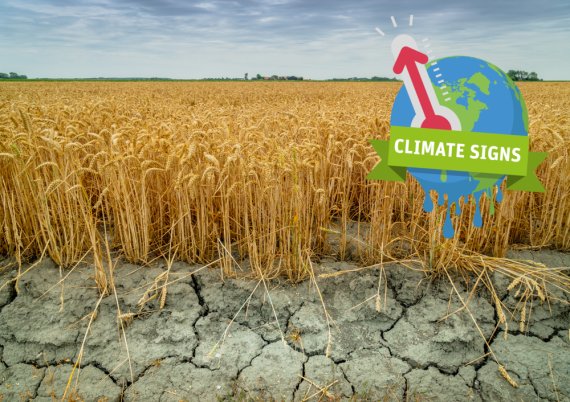© Shutterstock
| "Climate signs" | Climate change is not about the future — it is happening now and we can already see the effects. In its ‘Climate Signs’ series, Resource will be looking over the summer at how climate change affects people’s daily lives all around the world and what WUR researchers are doing about this issue. |
|---|
What do we consider to be drought?
‘That is an interesting question, as there are several definitions for it. In agriculture, we speak of drought when crops do not receive sufficient water to produce optimally: in other words, when they do not produce the expected yield. In the absence of rain, a farmer can still irrigate, which means that agriculture will suffer only once there is no water to irrigate. In that case, the definition is not as much about the rainfall, but specifically about how much water is available. If one depends merely on rainfall, then drought will occur much sooner. Drought is therefore a very elastic concept.’

The Netherlands does not get less rainfall, but it is spread differently.
Gerard van der Linden, Plant Breeding researcher
What is the influence of climate change?
‘It is rather complex, but there is a clear trend. The weather is changing all over the world. The Netherlands does not get less rainfall, but it is spread differently. We now have longer periods of drought, with very heavy showers following in a short time afterward. I’m not a climate scientist, but I too am heavily concerned about the tipping points. I see changes accelerating all around, and I think we should take action before it’s too late. Even if we can counteract the strong turn, we’re already dealing with a different situation which we must learn to deal with.’
It is conceivable that, in the future, we will only grow certain crops that need large amount of water, like rice and potatoes, in places where sufficient water is available.
What can we already notice of this?
‘Crops that we originally grew in the Netherlands are no longer doing well. For example, I can imagine there are onion farmers who, after the bad harvests of the past few years, wonder whether they should plant onions again next year. Onions are very susceptible to drought anyway, because they need water to fill the bulb. Otherwise they mature too early. In addition, the plant weakens, making it more susceptible to disease, such as thrips infection. Furthermore, drought causes freshwater and groundwater to salinise. This currently gives rise to many problems in places such as the Mekong Delta in Vietnam. In the Netherlands, we haven’t noticed much of it yet thanks to a very good water management system, but last year, the agriculture in Zeeland did suffer from salinisation.’
How do plants deal with drought?
‘Drought is particularly harmful in the period that is most important for the harvest, for example for a seed crop, which is when the plant blooms and produces seeds. This is because it is difficult for the crop to recover from this, as even if water become available afterwards, no new flowers are produced, and therefore no additional seeds either. An additional issue is that it is not just becoming drier but also hotter. Plants can cool themselves efficiently by “sweating” through their stomata, but they require water in order to do so. When the weather is hot and dry, the plants also suffer from additional heat stress, which becomes apparent from the yellowish-brown dots on leaves, or potatoes that produce more shoots. These are all additional problems.’
We are investigating when crops are most sensitive to drought, which could allow farmers to adjust water management optimally and distribute the water smartly and fairly.
What can we do to prevent it?
‘For one, we are developing plant varieties that have higher salt tolerance, need less water and are resistant to diseases, so that pesticide use can be decreased. In addition, we are investigating when crops are most sensitive to drought, which could allow farmers to adjust water management optimally and distribute the water smartly and fairly. This could mean that in the event of a water shortage, onions are given priority for water over maize. In the Netherlands, we only have a limited understanding of this nuance, as drought is a relatively new problem here. In the past, farmers had to worry much less about this aspect, as there was generally sufficient water available in stock for irrigation.’
What does the future look like?
‘It is conceivable that, in the future, we will only grow certain crops that need large amount of water, like rice and potatoes, in places where sufficient water is available. An additional issue in the case of wet rice cultivation in particular is that it releases a lot of methane and thus significantly contributes to the greenhouse effect. Dry rice cultivation is difficult due to other problems arising, because if the rice is not submerged in water, farmers have more trouble with weeds and diseases in the crops. Besides that, it is also possible that we will grow other crops. Quinoa is a crop that can withstand salt and drought very well, for example. In general, it can be grown with a quarter of seawater and still be economically justifiable. This would be interesting in the Netherlands, but also in other areas of the world that suffer from salinisation and drought, such as Vietnam, China, Bangladesh and Saudi Arabia.’
Previous articles in this series:
Increased heat stress in Dutch cities
From giant ticks to super-ants: invasive species are on their way
Himalayan meltwater is crucial for millions of farmers

